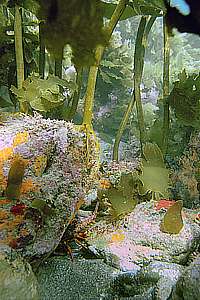 f017509: murky water causes untimely kelp death, the ones
lower down being starved of light first. This kelp forest along Great Barrier
Island, is symptomatic of habitat degradation occurring there.
f017509: murky water causes untimely kelp death, the ones
lower down being starved of light first. This kelp forest along Great Barrier
Island, is symptomatic of habitat degradation occurring there. |
 f016803: In January 1993, the whole kelp forest from Leigh
to Great Barrier, Mokohinau and Hen and Chickens, died from 10 metres down.
It was caused by dense plankton blooms, lasting for over six weeks, with
visibility less than 4m. The murky waters starved the kelp of light. The
next year, a similar disaster happened, and it took six years before the
kelp forest had a closed canopy again.
f016803: In January 1993, the whole kelp forest from Leigh
to Great Barrier, Mokohinau and Hen and Chickens, died from 10 metres down.
It was caused by dense plankton blooms, lasting for over six weeks, with
visibility less than 4m. The murky waters starved the kelp of light. The
next year, a similar disaster happened, and it took six years before the
kelp forest had a closed canopy again. |

































